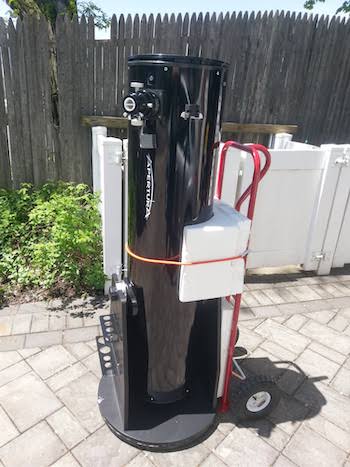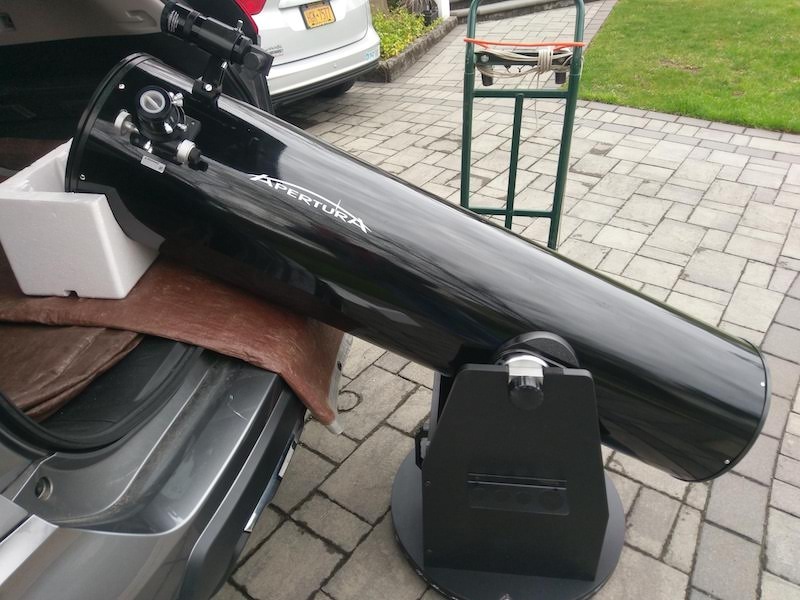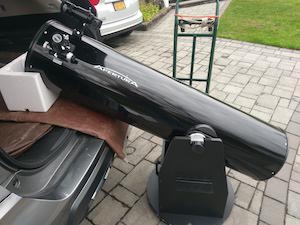Features of the Apertura AD series
- Aperture – 8”, 10” and 12”.
Aperture is the measure of the size of the mirror. The larger the mirror, the more light it gathers, the finer the detail that can be resolved, and the dimmer the targets that can be observed. In visual astronomy, the aperture is king, and the Dobsonian style of telescopes provides the most aperture per dollar.
The Apertura AD series includes the 8 inch F5.9, 10 inch F4.9, and 12 inch F5 models. AD8 and AD10 are very popular with first-time buyers. The 8” and 10” optical tubes fit easily across the back seat of most cars, in many trunks, or the back of an SUV. An aperture of 8 or 10 inches can show you a lot and, for many people, will be their lifetime large scope.
The Apertura AD12 is typically an upgrade scope. If you are considering the AD12, measure to be sure you can fit it in your car. The optical tube is 58” long. Most compact SUVs will handle this quite well. The photo shows the AD12 optical tube in the back of my 2018 Nissan Rogue. The mount fits nicely beside it, leaving the front passenger seat open for an observing buddy.

- Focuser – 2 Inch Two Speed
All three Apertura AD models come with a 2-inch two-speed focuser, which includes a 1.25” adapter. Many competitive models, such as the Orion SkyQuest XT series, Sky-Watcher Classic, and Flex-Tube series, have single-speed focusers.
The Apertura AD focuser is very smooth and handles large, heavy eyepieces very well. I have used a 2” eyepiece with a 2” 2X Barlow, total weight of around 2.5 pounds, with no problems.
The focuser has a high-speed knob that moves the eyepiece to the focus zone range quickly. There is a second dial that provides a 10:1 speed reduction that allows for very precise focusing. It also makes it easier to tweak the focus as atmospheric conditions change.
This dual-speed focuser was a key selection factor for me. It cost me over $200 to add a dual-speed focuser to my earlier Dob. After owning a two-speed focuser, I knew that I would never want to be without this feature again.
A 2-inch focuser allows you to use 2” eyepieces that can provide impressive low power wide views that can’t be provided by 1.25” eyepieces. Many first-time buyers underestimate the value of 2” low power wide view eyepieces, but experienced owners know how valuable this 2” focuser feature can be for viewing large deep sky objects and as an aid to star-hopping.
There is also an included 35 mm extension tube for the focuser. While I have never required this extender, some eyepieces need an extender to come into focus. If you have one of these, you would normally have to buy an extender, which can cost $25 to $50. Apertura includes the extender at no extra cost.
- Dobsonian Mount
Sometimes simple is better. A key weakness of many telescope systems is the mount. Weak mounts that are overloaded can be wobbly and frustrating to use. Sometimes the designs are complex and unintuitive, which can frustrate new and experienced users alike.
Enter the Dobsonian design. These mounts are very stable and easy to use altitude azimuth, AltAz, mounts which means that they move up and down as well as rotate left and right to make it easy to track your targets.
Unlike other Dobsonian mounts, the AD series has a roller bearing set in the base to provide buttery smooth motion. There is a tension adjustment knob so you can get just the right motion.
The side altitude bearings are adjustable to make it easier to balance your scope, even if you add extra finders or other accessories that will throw off the balance.
The altitude bearings also include a friction dial, so you can tune the movement to your preferred friction level during your observing session. This is helpful as you insert heavy eyepieces or when switching from heavy to lightweight eyepieces. A simple nudge of the altitude friction dial may be all you need to keep things operating smoothly.
The photo shows the mount and the azimuth friction adjustment knob in the center. This allows you to get just the perfect friction for smooth left-to-right movement.

Also shown is the modification I made. Note the cut-out and the 300 shown. I added an azimuth setting circle to the mount to make it easier to find targets using their altaz coordinates. The circular plates of the Apertura AD series mounts make this very easy to do.
I use a digital angle finder, that I purchased from Amazon, to set the altitude. This is a great alternative to star hopping, especially in a very light-polluted area.
- Finder – 8X50 RACI
Many Dobsonian telescopes in this class come with a simple, low-cost red dot finder. Examples would be the Orion SkyQuest XT series and the Meade Lightbridge Plus series. While these can be effective in darker locations, if you live in a light-polluted area, as I do, you may have few stars in the sky to use with the red dot finder. A magnifying finder, which is a small refractor telescope, can show you more stars as you search the sky for star groups that guide you to your target. I do some observing through this finder, which is similar to half of an 8X50 binocular.
RACI means that this finder provides a right angle diagonal and a correct image. Many magnifying finders present you with an image that is reversed left to right, which can make it a bit confusing to move the scope as you search for your target. The Apertura finder presents a correct image, which makes it very easy to move the scope to your desired target.
A right-angle finder, a purchase requirement for me, turns the finder eyepiece toward you and parallel to the telescope eyepiece. You can easily move from eyepiece to finder and back while comfortably seated.
Some scopes in this class include a straight-through magnifying finder, such as the Sky-Watcher Classic Dobsonian series. I find these very inconvenient to use with a Dobsonian telescope. You may have to get on your knees and into awkward positions to use a straight-through finder.
If you would like to add a second, non-magnifying finder, such as a Telrad, you will be pleased to see that there is plenty of space on the tube to add a second finder.
- Eyepieces – 2 Inch and 1.25”
It is common for Dobsonian telescopes to come with one or two 1.25” eyepieces, sometimes of lesser quality. The Apertura AD8, AD10, and AD12 come with a much more useful 2″ 30 mm 68 degree wide view eyepiece and a good quality 1.25” 9 mm Plossl eyepiece.
No doubt you will add more eyepieces over time, but if this is your first scope, these are better and more useful than what comes with almost any other competitive scope.
- Laser Collimator
I have been very surprised to see how many Dobsonian and Newtonian telescopes are sold without a basic collimation tool. Collimation is a simple process that ensures the mirrors are properly aligned to give you the best image possible. Collimation only takes a few minutes to perform.
Apertura could have included a cheap collimation cap and met the need. A collimation cap works but can be very inconvenient to use on scopes of this size.
Apertura provides a much more useful laser collimator with the AD series. This makes collimating these AD8, AD10, and AD12 scopes a snap. Slip it into the focuser, lock it in, and you will know right away if your scope is collimated. Making simple adjustments is quick and easy thanks to the laser collimator.
The photo shows the Moon filter, laser collimator, batteries, and the focuser extension tube that are included with the Apertura AD series telescopes.

- Moon Filter
The Moon is so bright, especially when it is near full, that it can be uncomfortable to view without a filter in a scope of 8” or larger. I feel a Moon filter also improves contrast. The included filter works well on the included 9 mm Plossl eyepiece as well as any other 1.25” eyepieces you add.
- Eyepiece Tray
A tray is a very convenient place to put your eyepieces when you are observing. The included 4 hole try has room for a 2” as well as three 1.25” eyepieces. When you set-up, just put your eyepieces in the tray and you are ready to go.
- Primary Mirror Cooling Fan

If you keep your scope indoors, when you bring it outside, the mirror will be at a different temperature than the surrounding air. While you wait for your scope mirror to become acclimated to the surrounding temperature, you can use it, but high power performance may be compromised until the scope warms up or cools down as needed.
Apertura includes a fan to help the primary mirror come to an optimum temperature quickly. This shortens that warm-up/cool-down time. This can also be very helpful in keeping the mirror at an optimum temperature if the temperature is changing rapidly. You will be very happy to have this valuable feature. This is an extra cost option on many other scopes.
- Size and Weight
As I said earlier, the Dobsonian design, based on the Newtonian optical tube and the Dobsonian mount, is the price-performance leader. However, compared to other telescope designs, Dobsonian telescopes can be considered large and somewhat heavy.
- 8” Optical Tube – 24.5 pounds and 46.5” Mount 27.7 pounds
- 10” Optical Tube – 34.8 pounds and 48.5” Mount 31.4 pounds
- 12” Optical Tube – 47.8 pounds and 57.5” Mount 38.3 pounds

While the numbers may give you pause, note that the optical tube is easily lifted off the mount and moved separately. You can also use a cart or hand truck to move them around if you don’t wish to carry them. That is what I do.
If you can store your telescope at ground level, the size and weight can easily be managed using a cart or hand truck. The photo shows my AD12. It lives in my garage on a hand truck. When I want to use it, I just roll it out to the observing site on my property. This makes handling this large scope very easy.
When going to a dark site with my 12”, I just tip the optical tube into the car and lift it from the mirror end and slide it in. The white blocks in the photo came in the shipping box with the telescope. The 10” and 8” are smaller and lighter and even easier to handle.

The Newtonian Reflector and Coma
All telescope optical tube designs are based on a set of compromises. They are optimized for size, weight, or perhaps cost, and they all have some sort of optical challenge.
Refractors, for example, exhibit chromatic aberration, a false-color glow around the edge of objects. Entry-level achromatic refractors can exhibit quite a bit of CA. Higher-end apochromatic refractors virtually eliminate CA but at a much higher cost and added weight.
The Dobsonian/Newtonian offers the best price-performance ratio, but it is not perfect. Aside from its physical size, the most notable optical issue is coma. Coma is a property that comes from using a parabolic mirror, and all the better Newtonian/Dobsonian telescopes use parabolic mirrors, so all Newtonian/Dobsonian telescopes exhibit coma.
Coma manifests itself along the peripheral of the field of view. Stars at the edges start to elongate in their appearance, starting to exhibit a tail-like shape, similar to a comet, which is where the name is derived. So, how much of a concern is coma?
I have owned and used Newtonian/Dobsonian telescopes with focal ratios of F4 to F8. All, including the Apertura AD12 I own today, have exhibited coma. However, the coma has never been an issue for me. I know it is there, at the edge of the field, but my attention is focused on the center area of the field of view, so if the edge stars are a little elongated, it has never bothered me.
Astrophotographers pay a great deal of attention to coma. Visual observers are usually less bothered by coma. However, if coma bothers you, there is a solution, the coma corrector, which can greatly reduce coma.
Coma correctors run from about $120 for a GSO coma corrector to about 3x for a Tele Vue coma corrector. They can be added at any time.
A coma corrector is placed into the focuser and then the eyepiece is placed into the coma corrector, similar to how a Barlow lens is used. There is usually some tuning you do at the initial set-up to optimize the correction for your scope.
Coma is common to all Newtonian optical tubes that use a parabolic mirror, which is virtually all of them. Many people ignore it, but if it bothers you it can be addressed later on by adding a coma corrector.

